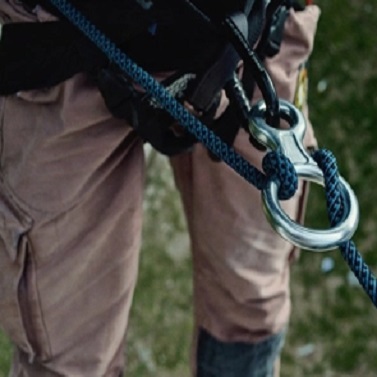At a glance, all ropes might look the same—just long, strong, and ready to tie into something. But when it comes to climbing, not all ropes are created equal.
Whether you're scaling a cliff face or ascending into a tree canopy, the type of rope you use makes a huge difference in safety, performance, and comfort.
So, what's the difference between climbing rope (used in rock climbing) and arborist rope (used in tree care and canopy work)?
| Feature | Climbing Rope | Arborist Climbing Rope |
Primary Use | Rock climbing, mountaineering | Tree climbing, arboriculture |
Rope Type | Dynamic (stretches to absorb falls) | Static or semi-static (minimal stretch) |
Materials | Nylon (dynamic core) | Polyester or nylon blend (low stretch) |
Diameter | 8.5mm–11mm | 11mm–13mm (often thicker) |
Abrasion Resistance | Moderate | High (for bark friction) |
Typical Environment | Rock walls, vertical faces | Trees, branches, canopy systems |
Certifications | UIAA, CE (for dynamic climbing) | ANSI Z133, EN 1891 (for arborist use) |
Climbing rope, used in traditional and sport climbing, is specifically designed to handle dynamic forces—like the sudden shock of a fall.
Dynamic Rope: Built to stretch under load, reducing impact force.
Static Rope: Low-stretch rope used for rappelling or hauling—not for lead climbing.
Made from nylon with a dynamic core
Typically lighter and thinner
Optimized for vertical movement
Certified by UIAA and CE for fall protection
Lead climbing
Top rope climbing
Ice climbing
Mountaineering
An arborist climbing rope is built for tree care professionals (a.k.a. arborists) who climb trees to prune, rig, or remove branches. These ropes are typically static or semi-static, meaning they have very little stretch, which is essential for controlled movements and safety in a tree canopy.
Made from polyester or blended fibers for low stretch and high strength
Designed to withstand abrasion from tree bark
Offers more grip, more diameter, and better knot-holding capability
Often used with systems like SRT (single rope technique) and DRT (double rope technique)
Tree climbing and work positioning
Canopy access and rope walking
Arborist rigging systems
Rescue and aerial work
Arborist ropes are built for precision, durability, and control—not for absorbing dynamic falls.
One of the biggest differences comes down to this:
Climbing ropes stretch. Arborist ropes don’t.
Dynamic ropes (used in rock climbing) stretch by 30–40% under load to absorb fall impact.
Arborist climbing ropes typically stretch less than 5%—they're meant for steady ascent and descent, not falls.
This is why using the wrong rope can be dangerous:
Using a climbing rope in a tree may bounce too much and make work unstable.
Using an arborist climbing rope on a rock wall offers no fall protection.
Not quite.
Arborist climbing rope: Used to support the climber.
Rigging rope: Used to lower and control limbs or branches during removal.
Each rope is designed to handle different types of force. Never use rigging rope to support your body—it’s not made for that.
When choosing a rope, look for compliance with relevant safety standards:
Climbing Rope:
UIAA Certified
CE EN 892 (dynamic ropes)
Arborist Climbing Rope:
ANSI Z133
CE EN 1891 (low-stretch kernmantle rope)
These standards ensure the rope is tested for load capacity, elongation, durability, and safety.
| Your Task | Use This Rope |
Rock climbing, gym climbing | Dynamic climbing rope |
Rappelling or hauling gear | Static rope |
Pruning or working in a tree | Arborist climbing rope |
Lowering branches | Arborist rigging rope |
Recreational tree climbing | Arborist rope (preferably 11mm–12mm) |
Here are a few trusted names in the industry:
Samson Rope – Known for robust arborist lines
Yale Cordage – High-performance climbing and rigging ropes
Teufelberger – Makers of Xstatic and Tachyon ropes
Sterling Rope – Cross-industry ropes with ANSI-rated arborist options
If you’re looking for a dependable arborist climbing rope, these brands are a good starting point.
Climbing rope is designed to stretch and protect you from falls.
Arborist climbing rope is built to keep you steady and secure in trees, with minimal stretch and high durability.
Using the right rope for the job is more than just about comfort—it’s about safety, efficiency, and control. Whether you’re scaling granite or climbing a 100-foot oak, make sure your rope is up to the task.


